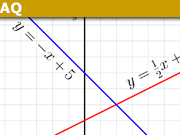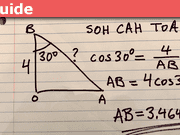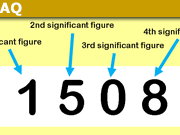Is There a Rigorous Proof Of 1 = 0.999…?
Yes.
First, we have not addressed what 0.999… actually means. So it’s best first to describe what on earth the notation [tex]b_0.b_1b_2b_3…[/tex] means. The way mathematicians define this thing is
[tex]b_0.b_1b_2b_3…=\sum_{n=0}^{+\infty}{\frac{b_n}{10^n}}[/tex]
So, in particular, we have that
[tex]0.999…=\sum_{n=1}^{+\infty}{\frac{9}{10^n}}[/tex]
But all of this doesn’t really make any sense until we define what the right-hand side means. There is an infinite sum there, but what does that mean? Well, we put
[tex]S_k=\sum_{n=1}^{k}{\frac{9}{10^n}} \ ,[/tex]
then we have a finite sum. So, for example
[tex]S_1=0.9, \ ~S_2=0.99, \ ~S_3=0.999, \ etc.[/tex]
So, in some way, we want to take the limit of this sequence.
Let’s consider a particularly simple sequence to illustrate the idea behind the definition of a limit of a sequence: 1/2, 1/3, 1/4,… The terms in this sequence get smaller and smaller. You might think that it’s obvious that it goes to 0, or that it’s obvious that a smart mathematician can prove that it goes to 0, but it’s not. It’s impossible to even attempt a proof until we have defined what it means for something to go to 0. So we have to define what the statement “1/2, 1/3, 1/4,… goes to 0” means before we can attempt to prove that it’s true.
This is the standard definition: “1/n goes to 0” means that “for every positive real number [itex]\epsilon[/itex], there’s a positive integer N, such that for all integers n such that [itex]n\geq N[/itex], we have [itex]|1/n| < \epsilon[/itex]”. With this definition in place, it’s quite easy to prove that “1/n goes to 0” is a true statement. What I want you to see here, is that we chose this definition to make sure that this statement would be true. The first mathematicians who thought about how to define the limit of a sequence might have briefly considered definitions that make the statement “1/n goes to 0” false, but they would have dismissed those definitions as irrelevant because they fail to capture the idea of a limit that they already understood on an intuitive level.
So the real reason why 1/n goes to 0 is that we wanted it to! Similar comments hold for the sequence of partial sums that define 0.999… It goes to 1, because we have defined the concepts “0.999….”, “sum of infinitely many terms”, and “limit of a sequence” in ways that make 0.999…=1. Can we define number systems such that 1=0.999… does not hold? Of course! But these number systems are not as useful, because they don’t conform to our intuition about limits and numbers.
Now that we know what a limit and an infinite sum is, let me give a fully rigorous proof to the equality 1=0.999… This proof is due to Euler and it appears in the 1770’s edition of “Elements of algebra”.
We know that
[tex]0.999…=\sum_{n=1}^{+\infty}{ \frac{9}{10^n} } = \frac{9}{10} + \frac{9}{10^2} + \frac{9}{10^3} +…[/tex]
This sum is a special kind of sum, namely, it’s a geometric sum. For (infinite) geometric sums, we can find its limit easily:
Let
[tex]x=\frac{1}{10}+\frac{1}{10^2}+\frac{1}{10^3}+…[/tex]
Then
[tex]9x=0.999…[/tex]
But, we also have [itex]10x=1+\frac{1}{10}+\frac{1}{10^2}+…[/itex], so [itex]10x-x=1[/itex].
This implies that [itex]x=\frac{1}{9}[/itex].
Hence,
[tex]0.999…=9x=1[/tex]
Does this proof look familiar? It should! It is essentially the same as Proof #2 in the previous post. The only difference is that every step is now justified by operations with limits.
See this supportive article: https://www.physicsforums.com/insights/why-do-people-say-that-1-and-999-are-equal/
The following forum members have contributed to this FAQ:
AlephZero
Fredrik
micromass
tiny-tim
vela
Advanced education and experience with mathematics








Test message.
I can easily show to someone what 1 or 2 of something means without requiring of anyone even a rudimentary knowledge of mathematics.
It is said (somewhere, sorry for not providing a proper cite) that prairie dogs cannot count — not even to 2, so they can't distinguish between 1 coyote and 2 coyotes — they know the difference between coyote and no coyote but anything in the how many realm is beyond them. This enables coyote teams to catch prairie dogs by 1 of them chasing a prairie dog into its burrow, then digging after it, and then the coyote's team partner pouncing on the hapless prairie dog when in an effort to escape coyote danger it emerges from the hole at the other end of the burrow, where the partner coyote is waiting in experienced anticipation.
A crafty bakery vendor sells bread loaves, only in whole-loaf increments — 1 loaf for 10 cents (1963 price). A crafty buyer says she (there was unabashed sexism then, and women were the main household food buyers) will pay 9.999… cents for 1 loaf of bread. The vendor says he (yes most of the sellers were male) will be glad to give her the loaf when she gives him the dime, but he's not willing to wait until after the series of 9s after the decimal point finishes recurring to get paid. He needs the whole dime to complete the transaction — she gets the whole loaf when he gets the whole dime. So they smile at each other, he and she do the loaf for dime exchange as offered by him and accepted by her, and she leaves with the bread and he puts the (about 90% silver — it's a 1963 coin) dime in his cash drawer.